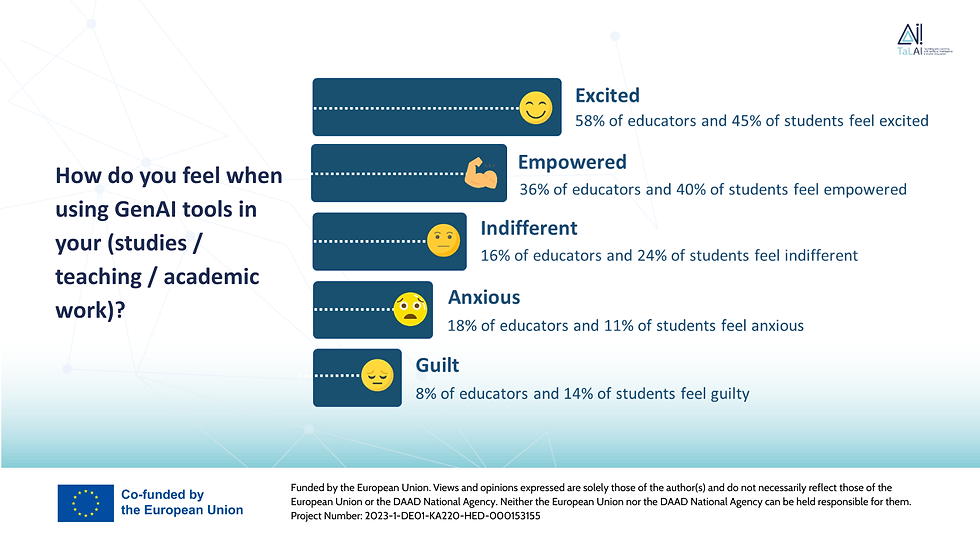Over 70% of surveyed educators allow GenAI use in graded assessment
- doviledudenaite
- May 9
- 4 min read
Generative Artificial Intelligence (GenAI) is no longer just a futuristic concept - it's becoming part of the everyday toolkit for students and educators alike. Tools like ChatGPT are changing how learning and teaching are approached, how ideas are developed, and even how learning is measured. But alongside these new opportunities come questions about fairness, integrity, and the future role of education itself.
To better understand how GenAI is currently used and perceived, the ERASMUS+ project Teaching and Learning with Artificial Intelligence (TaLAI) conducted a study involving over 150 students and more than 100 educators across Europe. The results provide a glimpse into a landscape full of enthusiasm, experimentation, and some cautious hesitation. While many see generative AI as a valuable aid for learning and teaching, concerns around ethics, academic standards, and institutional guidance remain front and centre.
This blog post highlights some of the key findings from the study, offering insight into how GenAI is being integrated into higher education - and what still needs to happen to ensure its responsible and effective use.
Widespread use of ChatGPT
Among respondents, ChatGPT emerged as the most widely used GenAI tool, with over 70% naming it as their “number one tool.” Around 55% of students and 51% of educators reported using GenAI tools several times a week or more frequently, citing uses ranging from brainstorming and summarising to writing assistance. Other tools, such as Grammarly and image generators, were used less frequently but still contributed to academic workflows.
Students and educators show enthusiasm, but also uncertainty
More than 58% of educators and 45% of students reported feeling excited about using GenAI in teaching and learning contexts, highlighting a general sense of enthusiasm around its potential. At the same time, 18% of educators and 11% of students expressed anxiety, and 8% of educators along with 14% of students reported feelings of guilt. These emotional responses suggest a degree of uncertainty and discomfort, likely linked to unclear boundaries around what constitutes acceptable use of GenAI in academic settings.

Most educators allow GenAI use in graded assignments
Among educators, most expressed concern about the ethical implications of GenAI, particularly its impact on academic integrity and the learning process. While there was a general openness to incorporating GenAI into teaching, many voiced reservations about its long-term effects on students’ decision-making, memory, creativity, and ability to think independently.
Despite concerns, educators are experimenting with integrating GenAI into assessment. To gain insight into current practices, we asked participants how they manage the use of GenAI in graded assignments. This question was directed specifically at professors, lecturers, and researchers within the educator group who have direct classroom involvement. The responses reveal a range of approaches: 28% of educators allow GenAI use broadly in assignments, while a larger portion - 43% - permit its use only for specific purposes. In contrast, 28% do not allow GenAI use in any graded assignments. This means that most surveyed educators - around 72% - allow GenAI use at some level, either broadly or in a more controlled, specific context. This distribution suggests that most educators are open to integrating GenAI in their teaching as well as graded assignments.
Call for institutional support
Both students and educators are calling for more structure. Students want practical, clear guidance on appropriate GenAI use, while educators seek training, resources, and updated pedagogical models. Both groups agreed that GenAI should be part of the academic conversation—but agreed just as strongly that current institutional support is insufficient.
Key takeaways
The use of GenAI in higher education is rapidly expanding, with both students and educators showing strong engagement and interest. A key takeaway from the study is the remarkable similarity between students and educators in terms of how intensely they use GenAI, the emotions they associate with it, and their perceptions of its impact on learning.
Importantly, over 70% of educators now permit some level of GenAI use in graded assignments, indicating a shift towards cautious acceptance. However, ethical concerns remain prominent, with educators particularly alert to issues of academic integrity.
The study also highlights either a lack of institutional policy on GenAI use or insufficient communication of existing policies. Nearly 49% of students reported being unsure whether a policy exists or stated that none was in place, compared to 46% of educators—pointing to a lack of policies or a significant gap in awareness and policy dissemination across both groups.
Finally, the findings stress the need for stronger institutional support, including clearer guidelines, dedicated training for educators, and resources for students. These steps will be essential to ensure the responsible, equitable, and effective integration of GenAI into teaching and learning practices.
This blog post presents just a snapshot of our study findings. For a comprehensive analysis and in-depth discussion, we encourage you to read the full article, "Use and Perception of GenAI in Higher Education: Insights from the ERASMUS+ Project 'Teaching and Learning with Artificial Intelligence' (TaLAI)."
Editor's note: This article was originally published in MLA's newsletter.





Comments